![]()
Can You Learn Carnatic Music by Yourself? Self-Learning vs Guided Instruction Guide
Can you learn Carnatic music by yourself? Discover realistic expectations, effective self-learning strategies, and when professional guidance becomes essential for authentic musical development.

Introduction
“Can I just use YouTube and apps to teach my daughter Carnatic music?” asked Priya during a late-night conversation with her husband in their Fremont home. With their 9-year-old showing genuine interest in Indian classical music, they were torn between the convenience and cost-savings of self-learning versus investing in formal instruction.
If you’re wondering whether you can learn Carnatic music by yourself, you’re asking a question that thousands of Indian-American families grapple with. In our DIY culture where online tutorials exist for everything from cooking to coding, it’s natural to wonder if traditional music education can be self-taught too.

The short answer is: Yes, you can learn some Carnatic music by yourself, but with significant limitations. The longer, more helpful answer involves understanding what self-learning can realistically achieve, where it falls short, and how to make the smartest decision for your family’s musical goals.
This comprehensive guide examines the realities of self-teaching Carnatic music, compares various DIY approaches with guided instruction, and helps you determine the best path forward. Whether you’re a budget-conscious parent in Texas, a busy professional in California, or an adult learner in New York exploring your options, this analysis provides the clarity you need.
By the end of this article, you’ll know exactly what’s possible with self-learning, what requires expert guidance, and how to create a realistic plan that matches your goals, timeline, and resources.
Table of Contents
The Reality of Self-Learning Carnatic Music
What You Can Realistically Achieve on Your Own
Can you learn Carnatic music by yourself? The answer depends on your definition of “learning” and what you hope to accomplish.
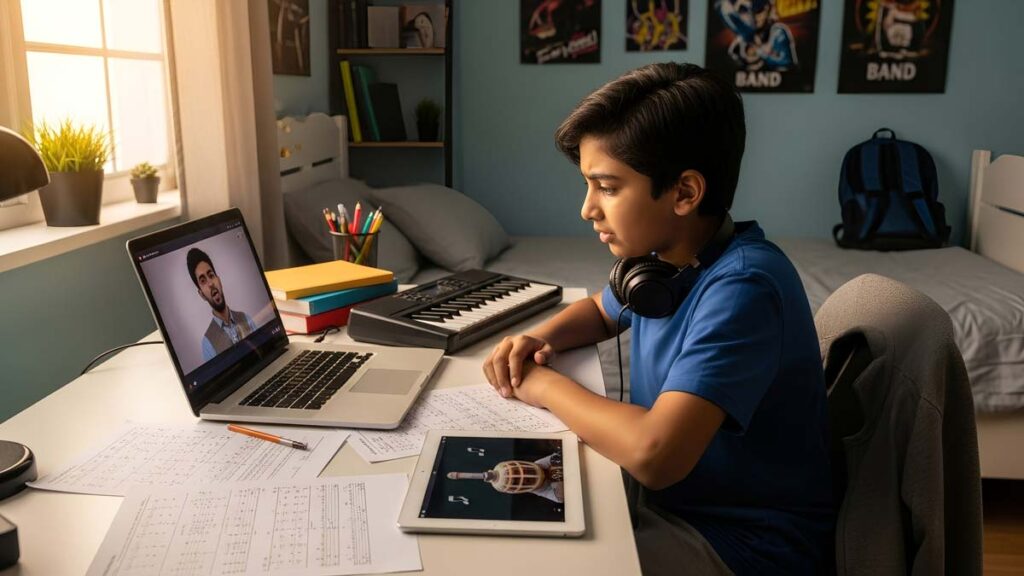
✅ What Self-Learning CAN Accomplish:
Basic Familiarization (3-6 months of self-study):
- Learning the seven swaras (Sa Re Ga Ma Pa Da Ni) and their sounds
- Understanding basic concepts like raga and tala in theory
- Memorizing 2-3 simple songs through repetitive listening
- Developing basic pitch recognition through practice
- Gaining appreciation for Carnatic music’s beauty and complexity
Elementary Progress (6-12 months with dedicated effort):
- Singing simple compositions with reasonable accuracy
- Following along with basic online tutorials and exercises
- Understanding fundamental theoretical concepts
- Building a small repertoire of familiar pieces
- Developing some cultural knowledge about composers and traditions
Intermediate Hobbyist Level (1-2 years of consistent self-study):
- Performing simple pieces for family gatherings
- Understanding several basic ragas and their characteristics
- Following more complex online tutorials and courses
- Developing personal practice routines and discipline
- Building confidence in cultural settings and family events
❌ What Self-Learning CANNOT Achieve:
Technical Precision and Authenticity:
- Correct intonation and pitch accuracy without expert feedback
- Proper breath control and voice production techniques
- Authentic pronunciation of Sanskrit and regional language lyrics
- Accurate rhythm and tala coordination
- Traditional ornamentations (gamakas) and stylistic nuances
Cultural Depth and Context:
- Deep understanding of spiritual and philosophical meanings
- Historical context and composer backgrounds
- Regional variations and traditional teaching methods
- Performance etiquette and cultural appropriateness
- Connection to living tradition and community practice
Advanced Musical Development:
- Improvisation skills (alapana, neraval, kalpana swaras)
- Complex compositions and advanced repertoire
- Teaching ability and knowledge transmission
- Performance confidence and stage presence
- Musical maturity and artistic expression
The Learning Curve Reality Check
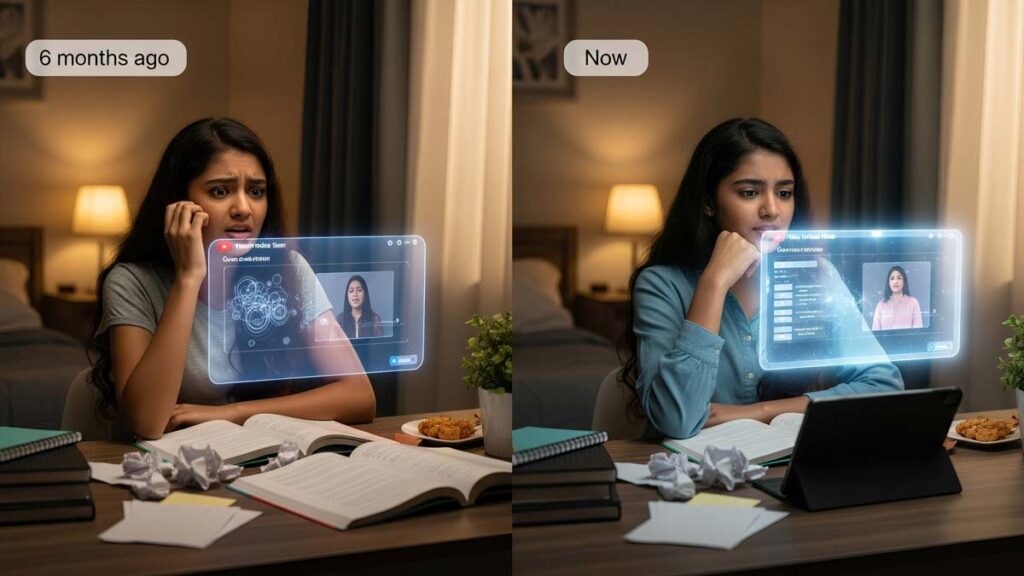
Realistic Timeline for Self-Learning:
Table Block:
| Time Period | Self-Learning Progress | Guided Learning Progress |
|---|---|---|
| 3 months | Basic swara recognition, 1-2 simple songs | Solid foundation, 3-4 compositions, proper technique |
| 6 months | Elementary understanding, basic performance | Structured repertoire, beginning raga knowledge |
| 1 year | Hobbyist level, family performance ability | Intermediate skills, cultural performances |
| 2 years | Plateau reached, limited further progress | Advanced compositions, beginning improvisation |
| 3+ years | Stagnation without expert guidance | Continued growth, teaching capability potential |
The Self-Learning Plateau: Most self-taught students hit a plateau around 12-18 months where progress slows dramatically without expert guidance. This is where the limitations of DIY learning become most apparent.
Popular Self-Learning Methods: Honest Assessment
YouTube Tutorials and Free Online Content
The Appeal: Free, accessible, vast selection of content from various teachers.
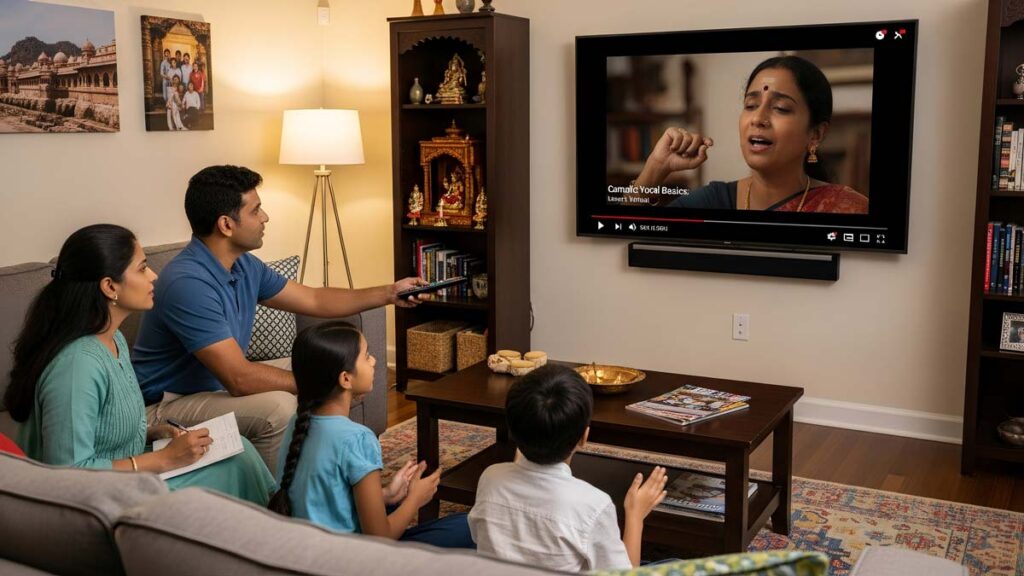
✅ YouTube Learning Advantages:
- Cost-effective: Completely free access to thousands of lessons
- Variety: Multiple teachers and teaching styles to choose from
- Convenience: Learn at your own pace and schedule
- Replay ability: Review difficult concepts multiple times
- Cultural exposure: Access to performances and cultural context
❌ YouTube Learning Limitations:
- No personalized feedback: Cannot correct your mistakes or technique
- Inconsistent quality: Wide variation in teaching expertise and accuracy
- Lack of structure: No systematic progression or curriculum
- Information overload: Too many options can be overwhelming and confusing
- No accountability: Easy to skip practice or give up when motivated
Best YouTube Channels for Carnatic Music:
- Established musicians with teaching experience
- Channels with systematic lesson progressions
- Content that includes cultural context and explanation
- Teachers who demonstrate proper technique clearly
Reality Check: YouTube can provide good supplementary learning but cannot replace personalized instruction for serious musical development.
Music Learning Apps and Online Courses
Popular Options: Various apps claiming to teach Indian classical music, online course platforms, and specialized music education software.
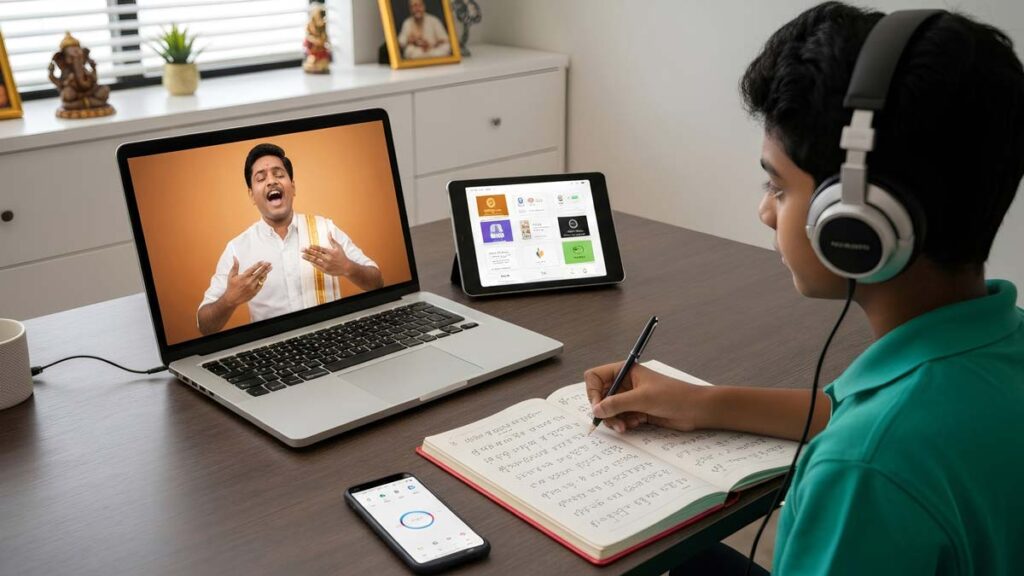
✅ App-Based Learning Advantages:
- Interactive features: Games, quizzes, and engaging learning tools
- Progress tracking: Built-in systems to monitor advancement
- Structured curriculum: Some apps offer systematic learning paths
- Portable learning: Practice anywhere with mobile devices
- Multimedia approach: Combination of audio, visual, and interactive elements
❌ App-Based Learning Limitations:
- Generic approach: Cannot adapt to individual learning styles or needs
- Limited cultural depth: Focus on technique over cultural understanding
- No real-time correction: Cannot fix vocal technique or pronunciation issues
- Subscription costs: “Free” apps often require premium subscriptions for full access
- Technology dependence: Reliance on devices rather than developing musical ear
Evaluation Criteria for Music Apps:
- Teacher credentials: Are lessons created by qualified Carnatic musicians?
- Cultural authenticity: Does content include proper cultural context?
- Progression logic: Is there a sensible learning sequence?
- User reviews: What do actual learners say about effectiveness?
- Trial options: Can you test the app before committing to payment?
Books, CDs, and Traditional Learning Materials
The Classic Approach: Learning from published materials, audio recordings, and written notation.
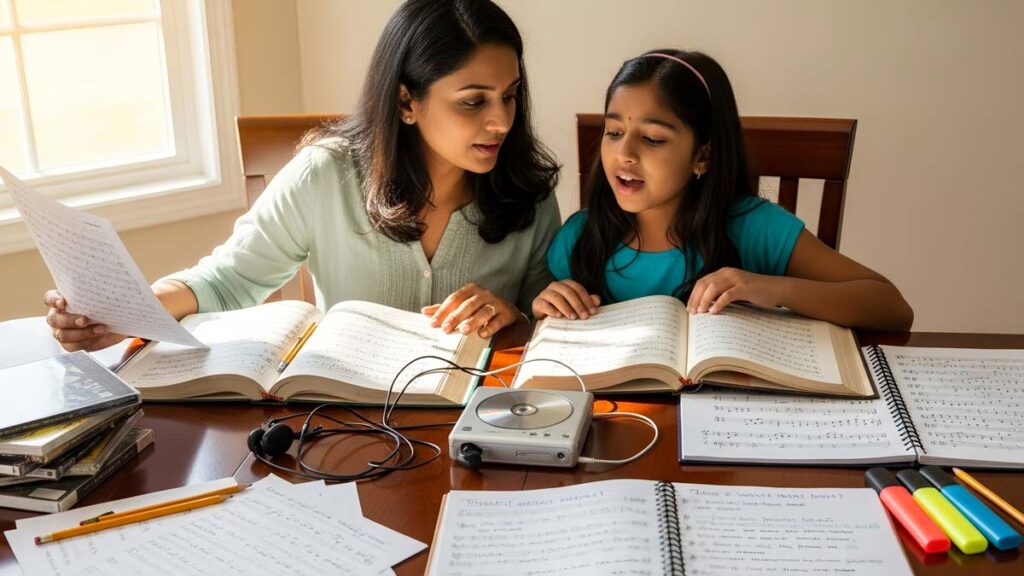
✅ Traditional Material Advantages:
- Systematic approach: Books often provide structured learning progressions
- Cultural authority: Materials by established musicians and institutions
- Deep content: Comprehensive coverage of theory and cultural context
- No technology dependence: Works without internet or devices
- Reference value: Permanent resources for ongoing study
❌ Traditional Material Limitations:
- No feedback mechanism: Cannot correct vocal technique or mistakes
- Static content: Cannot adapt to learner’s pace or difficulties
- Audio quality issues: Older recordings may have poor sound quality
- Language barriers: Many materials in regional languages or complex Sanskrit
- Outdated teaching methods: May not suit modern learning styles
Recommended Traditional Resources:
- Publications by established music institutions (like Music Academy, Madras)
- Materials by renowned musicians and pedagogues
- Modern books that bridge traditional knowledge with contemporary teaching
- Audio recordings by master musicians for reference
Self-Teaching with Online Guru Programs
The Modern Guru-Shishya Model: Structured online courses that attempt to replicate traditional teacher-student relationships.
✅ Online Program Advantages:
- Structured curriculum: Systematic progression designed by experts
- Expert instruction: Lessons by qualified, experienced musicians
- Some interaction: Email support or occasional feedback sessions
- Cultural integration: Often includes cultural context and tradition
- Flexibility: Self-paced learning with expert-designed content
❌ Online Program Limitations:
- Limited personalization: Still mostly one-size-fits-all approach
- Delayed feedback: Cannot get immediate correction during practice
- No relationship building: Lacks the personal connection of traditional guru-shishya
- Technical barriers: Requires good internet and technology comfort
- Motivation challenges: Self-discipline required without regular accountability
When Self-Learning Might Work for You
Ideal Candidates for Self-Learning Approach
Can you learn Carnatic music by yourself? For some people in specific circumstances, self-learning can be a viable starting point.
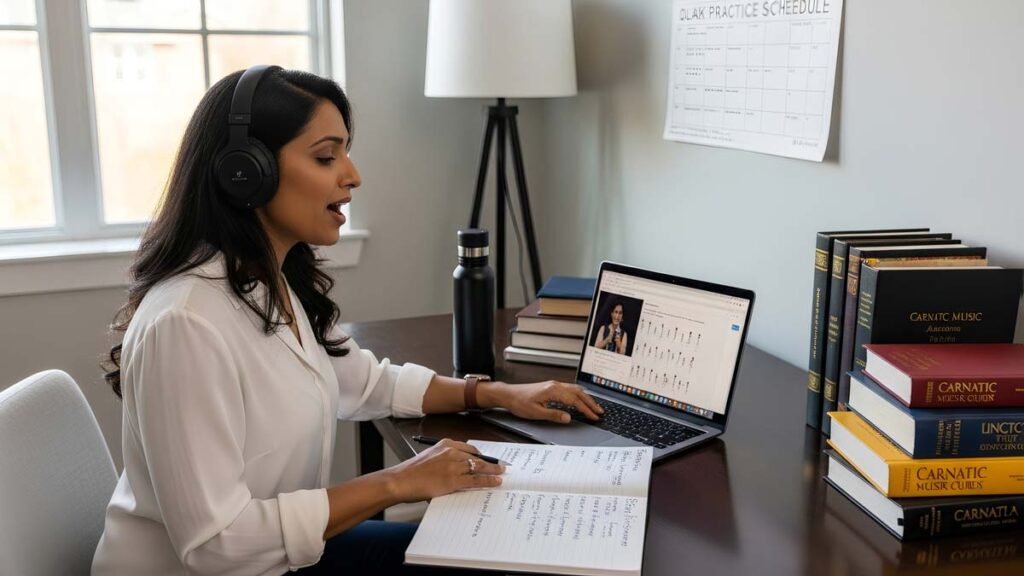
✅ You Might Succeed with Self-Learning If:
Personal Characteristics:
- Highly self-motivated: You have a track record of completing self-directed projects
- Musically experienced: You have previous training in other musical forms
- Culturally connected: You grew up listening to Carnatic music regularly
- Patient and persistent: You don’t get frustrated easily with slow progress
- Tech-savvy: You’re comfortable using various digital learning tools
Practical Circumstances:
- Limited budget: Cannot currently afford quality instruction
- Geographic isolation: No qualified teachers available in your area
- Schedule constraints: Cannot commit to regular lesson times
- Exploratory phase: Want to test interest before investing in formal learning
- Adult learner: Mature enough to self-assess and seek help when needed
Realistic Goals:
- Hobbyist level: Want to sing for personal enjoyment and family occasions
- Cultural connection: Primarily seeking heritage appreciation, not performance mastery
- Supplementary learning: Already have some formal training and want additional practice
- Preparation phase: Getting ready for formal lessons or evaluating commitment level
Success Strategies for Self-Learners
If you decide to try self-learning, maximize your chances of success:
🎯 Create Structure and Accountability:
- Set specific, measurable learning goals for each month
- Establish regular practice schedule and stick to it consistently
- Track progress through recordings and self-assessment
- Find online communities or forums for motivation and support
- Plan periodic evaluations with qualified musicians for feedback
🎯 Use Multiple Learning Sources:
- Combine YouTube tutorials, apps, books, and audio materials
- Cross-reference information from different teachers and sources
- Focus on quality over quantity – choose fewer, better resources
- Supplement with live performances and cultural events when possible
🎯 Seek Occasional Expert Guidance:
- Schedule periodic consultations with qualified teachers for assessment
- Attend workshops or masterclasses when available
- Join online forums where experienced musicians provide guidance
- Consider short-term intensive courses or summer programs
Red Flags: When to Abandon Self-Learning
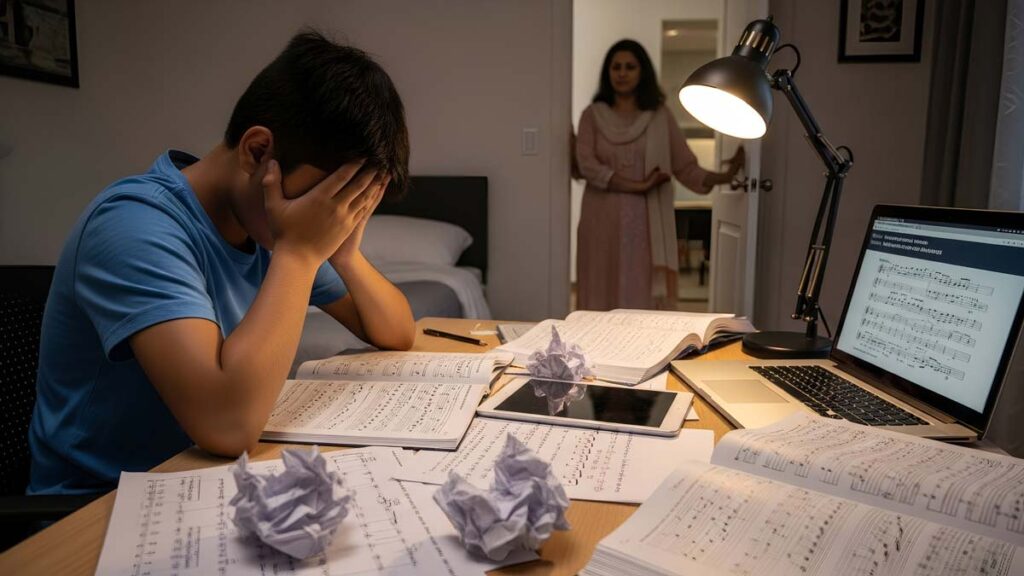
⚠️ Stop Self-Learning When:
Progress Indicators:
- No noticeable improvement after 6-8 months of consistent effort
- Developing bad habits in voice production or technique
- Increasing frustration rather than enjoyment with practice
- Unable to perform simple pieces accurately after extended practice
- Friends or family consistently point out pitch or rhythm problems
Learning Problems:
- Confusion about basic concepts despite multiple resource attempts
- Inability to follow along with beginner-level tutorials
- Developing physical tension or vocal strain during practice
- Feeling overwhelmed by the complexity without guidance
- Losing motivation and skipping practice sessions frequently
Cultural Concerns:
- Realizing you want deeper cultural understanding, not just song learning
- Feeling disconnected from the tradition despite technical attempts
- Wanting to participate in community cultural events with confidence
- Recognizing the need for authentic pronunciation and cultural context
The Case for Guided Learning: What You’re Missing
The Irreplaceable Value of Expert Guidance
While exploring can you learn Carnatic music by yourself, it’s crucial to understand what guided instruction provides that self-learning cannot replicate.

🎵 Real-Time Feedback and Correction:
What Expert Teachers Provide:
- Immediate technique correction: Fix vocal production and breathing issues before they become habits
- Personalized guidance: Adapt teaching methods to your individual learning style and pace
- Cultural authenticity: Ensure proper pronunciation, style, and traditional approach
- Progressive difficulty: Know exactly when you’re ready for more challenging material
- Motivation and encouragement: Provide support during difficult learning phases
Example: A self-learner might spend months practicing with incorrect pitch, while a teacher can identify and correct this within minutes of the first lesson.
🎵 Systematic Progression and Curriculum:
Structured Learning Path:
- Logical sequence: Each lesson builds upon previous knowledge systematically
- Skill integration: Combine technique, theory, and cultural knowledge effectively
- Plateau prevention: Know how to push through learning plateaus and challenges
- Goal setting: Establish realistic milestones and achievement markers
- Comprehensive development: Balance technical skills with cultural understanding
🎵 Cultural Transmission and Tradition:
Living Tradition Connection:
- Guru-Shishya relationship: Experience the traditional teacher-student bond
- Cultural context: Understand the spiritual and philosophical depth of compositions
- Community connection: Link to broader Carnatic music community and tradition
- Performance guidance: Learn appropriate behavior for cultural and religious settings
- Heritage preservation: Participate in maintaining and transmitting cultural knowledge
Swaramrit’s Guided Learning Advantage
Why Families Choose Expert Instruction Over Self-Learning:
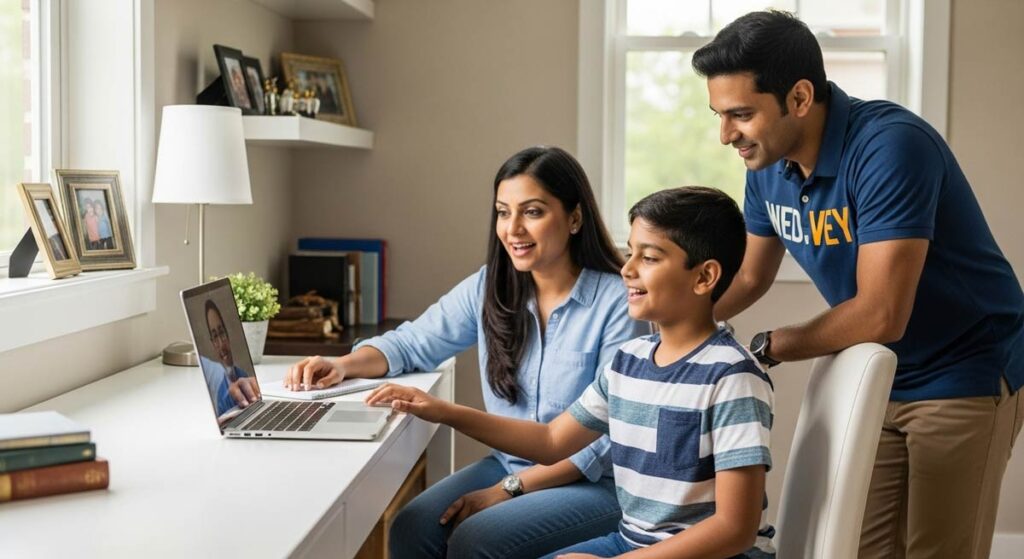
✅ Personalized “Learning through Encouragement”:
- Individual attention: 1-on-1 instruction tailored to each student’s needs and personality
- Positive reinforcement: Building confidence while maintaining high standards
- Adaptive teaching: Adjusting methods based on student response and progress
- Family involvement: Guidance for parents in supporting home practice effectively
✅ Cultural Authenticity and Depth:
- Master teacher expertise: Learn from M. Rajappa’s experienced faculty with deep traditional knowledge
- Complete cultural education: Understand the spiritual, historical, and cultural context of each piece
- Authentic pronunciation: Proper Sanskrit and regional language guidance
- Traditional values: Experience the respect, discipline, and devotion inherent in the tradition
✅ Comprehensive Support System:
- Recorded sessions: Review lessons for practice reference and technique reinforcement
- Progress tracking: Clear milestones and regular assessment of advancement
- Technical support: Seamless online learning experience with professional platforms
- Community connection: Virtual recitals and cultural events for performance experience
Hybrid Approach: Combining Self-Learning with Professional Guidance
The Smart Middle Path
For many families, the question isn’t whether you can learn Carnatic music by yourself OR with a teacher – it’s how to combine both approaches effectively.
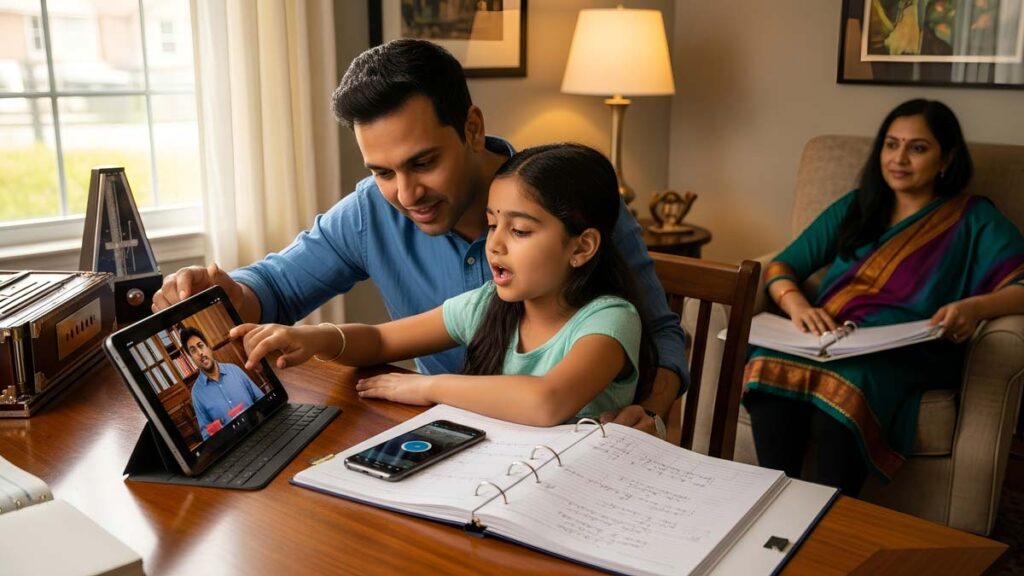
✅ Effective Hybrid Strategies:
Primary Professional Instruction + Self-Study Support:
- Weekly/bi-weekly professional lessons for technique, new material, and cultural context
- Daily self-practice using recorded lessons and provided materials
- Supplementary online resources for additional cultural knowledge and listening
- Family involvement in supporting and encouraging home practice
Intensive Short-Term Instruction + Extended Self-Practice:
- Monthly intensive sessions with qualified teacher for technique correction and new material
- Structured self-practice plan for the weeks between professional sessions
- Regular progress check-ins via video calls or recordings for feedback
- Seasonal workshops or masterclasses for advanced learning and inspiration
Assessment-Based Learning:
- Initial professional evaluation to establish foundation and identify learning needs
- Self-learning phase with recommended resources and structured practice plan
- Periodic professional review (every 3-4 months) for assessment and course correction
- Advanced guidance when ready for complex material requiring expert instruction
Making the Hybrid Approach Work
🎯 Communication with Your Teacher:
- Discuss your self-learning goals and methods openly
- Get recommendations for quality supplementary resources
- Report progress and challenges during professional sessions
- Ask for guidance on effective home practice techniques
🎯 Structured Self-Practice:
- Follow practice schedules provided by your teacher
- Use recorded lessons for technique reference
- Set specific goals for self-practice sessions
- Track progress to discuss during professional lessons
🎯 Quality Resource Selection:
- Choose self-learning materials recommended by your teacher
- Verify information from multiple sources before accepting as correct
- Focus on resources that complement your professional instruction
- Avoid materials that contradict your teacher’s methodology
Making Your Decision: Self-Learning vs. Professional Guidance
Decision Framework for Your Family
Can you learn Carnatic music by yourself? Use this framework to make the best choice for your specific situation:
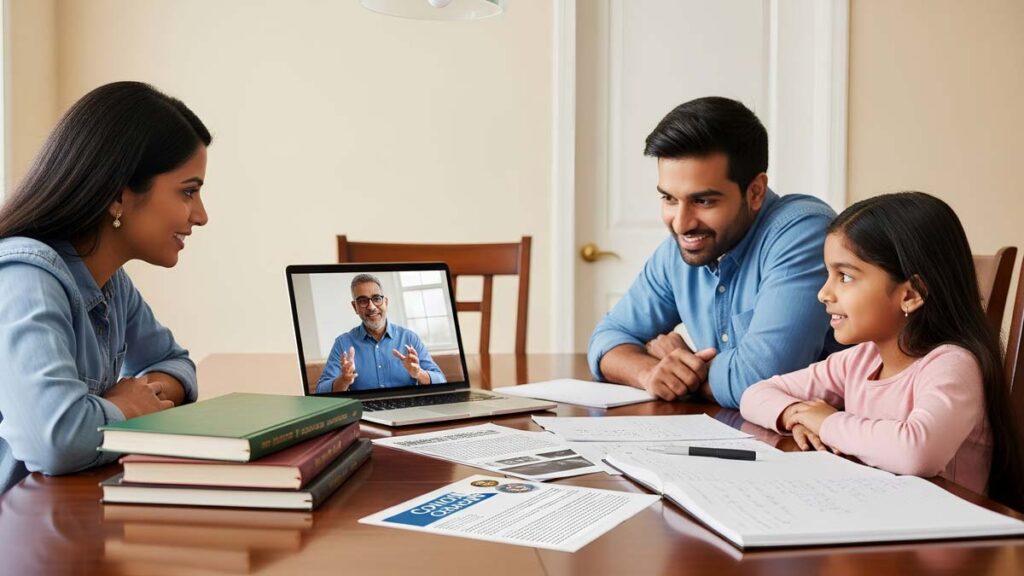
Choose Self-Learning When:
✅ Circumstances Favor DIY Approach:
- Exploratory phase: Want to test interest and commitment before investing
- Budget constraints: Cannot currently afford quality professional instruction
- Geographic challenges: No qualified teachers available locally or online
- Schedule limitations: Cannot commit to regular lesson times consistently
- Adult beginner: Mature learner with realistic expectations and self-discipline
✅ Goals Align with Self-Learning Capabilities:
- Hobbyist enjoyment: Want to sing for personal pleasure and family occasions
- Cultural appreciation: Primarily seeking heritage connection, not performance mastery
- Supplementary learning: Already have musical background and want cultural expansion
- Family activity: Learning together as a family bonding experience
Choose Professional Guidance When:
✅ Serious Musical Development Desired:
- Quality over convenience: Value authentic learning over cost/time savings
- Long-term commitment: Planning 2+ years of consistent musical development
- Cultural depth: Want comprehensive understanding of tradition, not just songs
- Performance goals: Aspire to community performances or advanced musical capability
- Child learners: Young students who need expert guidance for proper development
✅ Family Priorities Support Investment:
- Cultural preservation: Music education is important family value and priority
- Educational investment: Willing to invest in quality instruction for long-term benefits
- Community involvement: Want connection to broader Carnatic music community
- Heritage transmission: Serious about passing cultural knowledge to next generation
Realistic Expectations Setting
Table Block:
| Learning Approach | Time Investment | Cost | Realistic Outcomes | Limitations |
|---|---|---|---|---|
| Pure Self-Learning | 5-10 hours/week | Free to $100/month | Basic familiarity, simple songs | Plateau at elementary level |
| App-Based Learning | 3-5 hours/week | $10-50/month | Structured basics, some progress | Generic, limited cultural depth |
| Hybrid Approach | 6-8 hours/week | $100-200/month | Steady progress with expert guidance | Requires coordination and discipline |
| Professional Instruction | 4-6 hours/week | $200-400/month | Authentic mastery, cultural depth | Higher investment, schedule commitment |
The Bottom Line: What Works for Long-Term Success
Research consistently shows that students with professional guidance:
- Progress 3-4 times faster than self-learners
- Develop authentic technique and cultural understanding
- Maintain motivation and continue learning long-term
- Build meaningful connections to tradition and community
- Achieve performance capabilities and cultural confidence
Self-learning works best as:
- Initial exploration before committing to professional instruction
- Supplementary support for professional lessons
- Cultural appreciation activity for families with realistic expectations
- Adult hobby pursuit with clear understanding of limitations
The most successful approach for serious cultural education: Professional guidance with structured self-practice support.
Frequently Asked Questions About Self-Learning
Q: How long does it take to learn Carnatic music by yourself?
A: With dedicated self-study (1-2 hours daily), you can achieve:
- 3-6 months: Basic familiarity with swaras and simple songs
- 6-12 months: Elementary performance ability for family occasions
- 12-18 months: Hobbyist level with limited repertoire
- 18+ months: Plateau without expert guidance for further progress
However, students with professional guidance typically achieve in 6 months what takes self-learners 12-18 months, and continue progressing where self-learners plateau.
Q: What are the best free resources for learning Carnatic music by yourself?
A: Quality free resources include:
- YouTube channels by established musicians (verify credentials)
- University music department online lectures and materials
- Cultural organization websites with educational content
- Music academy free introductory materials and recordings
- Traditional notation collections available online
Caution: Always cross-reference information from multiple sources, as quality varies significantly.
Q: Can children learn Carnatic music by themselves?
A: Children under 12 generally need adult supervision and guidance for effective self-learning. Challenges include:
- Limited attention span for self-directed practice
- Inability to self-correct technique mistakes
- Need for motivation and encouragement from adults
- Difficulty understanding cultural context independently
Children learn best with professional instruction complemented by family support at home.
Q: Is self-learning Carnatic music culturally appropriate?
A: While self-learning can introduce you to Carnatic music, the tradition values the guru-shishya (teacher-student) relationship as essential for:
- Proper cultural transmission and respect
- Authentic understanding of spiritual and philosophical contexts
- Community connection and traditional etiquette
- Blessing and guidance from qualified teachers
Self-learning as cultural exploration is acceptable, but serious practitioners should seek qualified guidance.
Q: What happens if I start with self-learning and want to switch to a teacher later?
A: This is common and often successful if you:
- Be honest about your self-learning background and any bad habits developed
- Remain open to having technique corrected or starting over with proper foundation
- Invest time in unlearning incorrect methods and relearning proper techniques
- Trust the process of systematic instruction even if it feels slower initially
Many Swaramrit students started with self-learning and successfully transitioned to structured instruction.
Q: How much can I save by learning Carnatic music by myself?
A: Immediate cost savings are significant:
- Self-learning: $0-100/month vs. Professional lessons: $200-400/month
However, consider long-term value:
- Self-learners often restart with teachers after hitting plateaus
- Quality instruction achieves better results in less time
- Professional guidance provides cultural authenticity and community connection
- Investment in proper instruction pays dividends throughout life
The question isn’t just cost – it’s value for your cultural and educational goals.
Conclusion: Making the Right Choice for Your Musical Journey
Can you learn Carnatic music by yourself? The honest answer is that you can make a start, develop basic familiarity, and even achieve elementary performance ability through dedicated self-study. But the deeper question is whether self-learning can provide the authentic cultural education, technical mastery, and spiritual connection that Carnatic music traditionally offers.
Key Takeaways for Your Decision:
🎯 Self-Learning Works For: Cultural exploration, budget-conscious beginnings, adult hobbyists with realistic expectations, and supplementary support for professional instruction
🎯 Professional Guidance Essential For: Serious musical development, authentic cultural transmission, children’s education, performance capability, and long-term musical growth
🎯 Hybrid Approaches Offer: Flexibility for families balancing cost, convenience, and quality while maintaining expert oversight and cultural authenticity
🎯 Realistic Expectations Matter: Understanding what each approach can and cannot achieve prevents frustration and helps align learning methods with actual goals
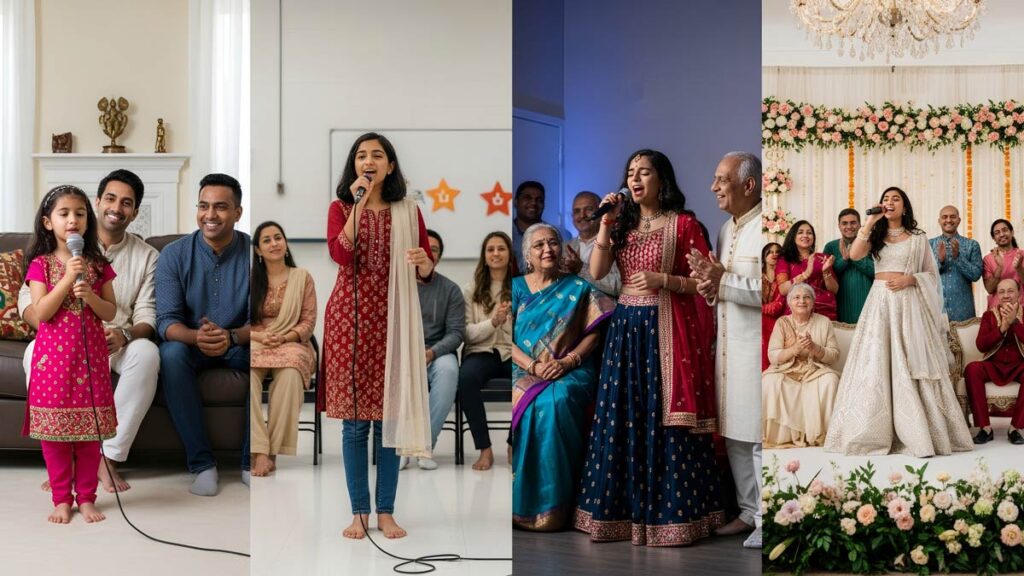
The most important insight: There’s no shame in starting with self-learning to explore your interest, but be honest about its limitations. Many successful musicians began with curiosity and self-exploration before committing to formal instruction.
For families serious about authentic Carnatic music education, Swaramrit’s professional online instruction provides the expert guidance, cultural depth, and systematic progression that self-learning cannot replicate. Our “Learning through Encouragement” approach has helped hundreds of students progress from curiosity to capability, often including those who started with self-learning attempts.
The question isn’t whether you’re “good enough” for professional instruction – it’s whether you value your cultural heritage enough to invest in authentic, quality education. Both your time and your cultural connection deserve the best guidance available.
Ready to move beyond the limitations of self-learning? Book a free trial lesson today for a consultation about how professional instruction can accelerate your musical journey while providing the cultural authenticity and community connection that make Carnatic music a lifelong treasure.
Continue Your Musical Education Research:
- Complete Guide to Online Carnatic Music Lessons – Comprehensive overview of quality instruction options
- Cost of Online Carnatic Music Lessons – Investment considerations for professional instruction
- Carnatic vs Hindustani Music Guide – Choosing the right classical tradition
- Learning Carnatic Music as an Adult – Specialized guidance for adult learners
